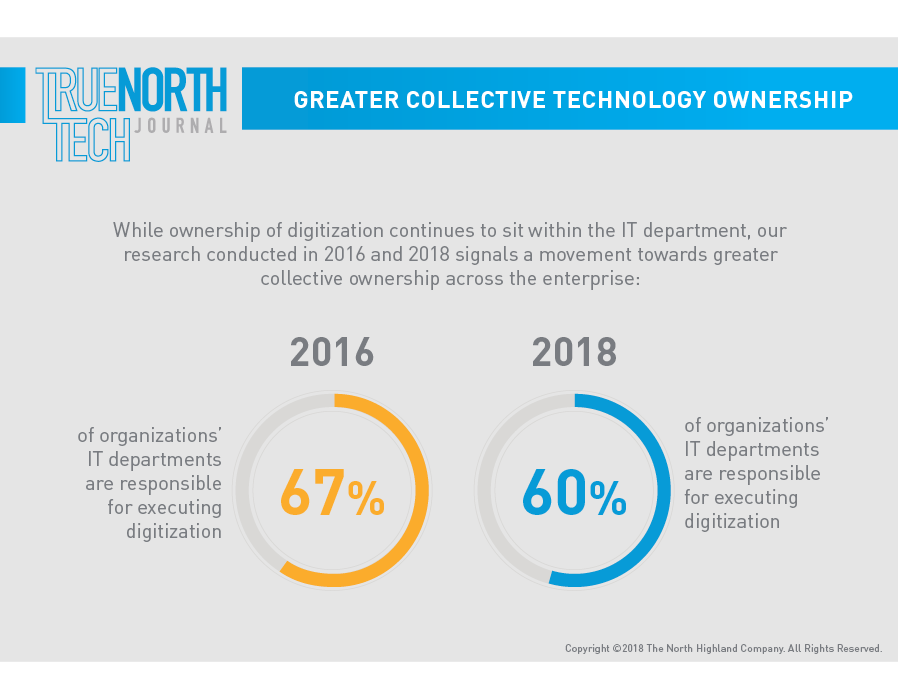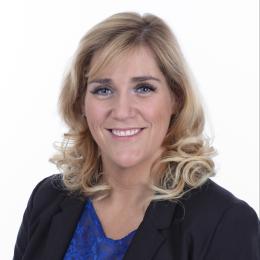
The need to integrate IT with the business is undoubtedly a strategic imperative. In fact, 85 percent of organizational leaders believe they have a narrow two-year window to advance their digital transformation efforts before business performance is compromised.
North Highland’s global Technology & Digital lead Ben Grinnell sat down with Femi Bamisaiye, Chief Information Officer of HomeServe, to share an in-depth look at the key success factors and failure points related to successful digitization. Based in Walsall, United Kingdom, HomeServe is a home emergency repairs business serving over eight million customers. Its vision is “to be the world’s most trusted provider of home repairs and improvements.”
Ben and Femi’s conversation illuminates the importance of a cross functionally-powered approach to digital transformation.
Digital transformation means changing nearly everything, from supply chain to employee enablement. But first and foremost, it comes down to the customer.
“Digital transformation is the application of digital technology to all aspects of the business and really putting the customer front and center. Ultimately, it has to be about driving customer value,” said Bamisaiye. “The faster you can get customer insight, the better.”
Yet, North Highland’s research from April 2018 shows that there’s room to grow and capture additional value from digitized customer interactions. Only 43 percent of respondents in our research report that a majority of their customer interactions are enabled by digital, yet nearly 80 percent of those who use digital to connect with customers believe they are successful.
If it all comes down to the customer, how do organizations get a digital transformation started? In his experience leading teams and building value from technology both in and outside of IT, Bamisaiye recommends the following principles:
- Be mindful. Take an outside-in perspective that’s informed by customer insights. Build the mechanisms to continuously collect – and, most important, learn and pivot – in response to customer feedback.
- Be smart. Leverage data to shape the course of your transformation.
- Be agile. Develop the right policies, incentives, and reward systems. Break down silos, reduce handoffs, and build the mechanisms to make quick decisions. In generating alignment, both Bamisaiye and Grinnell agree that communication is a key tactical step.
Becoming customer-centered requires its own cultural shift in attitudes, mindsets, and behaviors, particularly at HomeServe, where there are many stakeholders in direct interaction with customers, ranging from call center employees to engineers. In Bamisaiye’s words, “If we empower our people, and we give them the right capabilities and tools…to help the customer, then they will absolutely put the customer at the center of what they do.”
In discussing this cultural shift, Grinnell described a disconnect between employees on the front lines and those in leadership trying to transform the business. Both he and Bamisaiye recognize that a transformation can quickly fail; however, acknowledging that failure and learning from it is a critical operational muscle. “Be prepared to make mistakes. Be prepared to fail at doing something,” said Bamisaiye.
When scaling a digital transformation across functions, Grinnell warned leaders to steer clear of the “us and them” culture, where change is going well in one part of the organization but not in others. It’s important to ensure that transformation processes are aligned, even if they look different across departments and functions. Our research backs this stance, showing that leadership alignment ranks as the most important driver and key barrier to the adoption of technology tools.
Digital transformation requires a fundamental, culturally driven refocus on the customer, and that must accompany a willingness to be increasingly vulnerable to failures. Organizations are often afraid of being “seen badly” in front of the customer, but Bamisaiye said that companies need to get comfortable with the idea that “customers know you’re experimenting and want their input.” “[Then] they will engage,” he added.
With a cultural foundation set, how might digital transformation look in the future? “We’re seeing increased integration with business and a rise in cross-functional teams,” said Grinnell. As IT increasingly integrates with the business, he questions the existence of functional silos in five to 10 years’ time. Our research supports this hypothesis, signaling a shift in favor of greater cross-functional technology ownership.

As a leader of multidisciplinary teams at HomeServe, Bamisaiye agrees there’s an evolution happening around roles and functions. Teams need to be configured to “accelerate and make something happen… that means, at its heart, that silos are breaking down.”
In considering the fundamental change in ways of working that accompanies digital transformation, Ben commented, “it’s an interesting paradox… technology is not a support function, and I absolutely believe that, you’ve got to be leading technology experiments… but at the same time leading with technology is one of the biggest mistakes I’ve seen. Somewhere in the middle there, we’ve got to find the balance.”
Femi added, “It’s an interesting nugget to crack, no question about it…”
About Femi Bamisaiye
Femi is the Chief Information Officer at HomeServe, joining the organization in December 2017. His focus is on embedding technology to improve customer experiences, optimize costs, and accelerate the creation of value for internal and external stakeholders. In his career, he has served in several roles ranging from Technical Services Director to CIO, bringing a customer and people-first approach to leading global teams.

